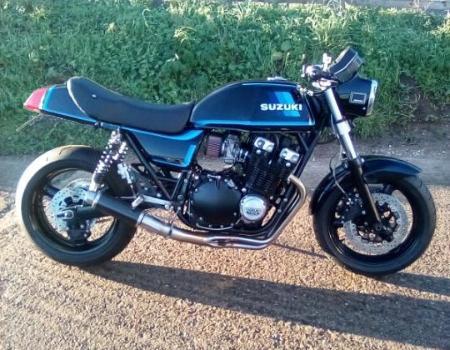-
Posts
309 -
Joined
-
Last visited
Reputation
187 ExcellentPersonal Information
-
Location
Rotterdam
Recent Profile Visitors
The recent visitors block is disabled and is not being shown to other users.
-
Very nice indeed. Not a fan of the cropped tail look though.. So had a quick go with Photoshop to fix that.
-
Had the same issue recently with a spare EFE head, and it turned out the cams were bent. On closer inspection I also found several small dings on these (Web) cams (bought on Eblag many years ago), indicating they were handled roughly at some time or got trapped under heavy stuff in storage or something. So putting your cams on V-blocks to measure runout, would be my suggestion (and Gixer1460's). I managed to straighten the bent cams in the press, taking small steps and first locating the position of the bend. On youtube some folks suggest beating a bent cam with a lead hammer was the right solution, but that approach felt wrong to me.
-

Anyone have repair manual for Suzuki GSX750 1981 (Euro model)?? = )
arnout replied to Anders74's topic in Air Cooled
GSX750ET service manual -
Yes, I've had this on my 1135 engined Kat, and I was puzzeld about it too at the time. That was my conclusion eventually. The seal at one of the oilways has failed, and oil would spread along the head gasket and seep out at the pin where there is no seal. (On some head gaskets this would not happen when a seal around the edge of the gasket is missing). In the block there is a threaded hole in the dowel pin, which is where a bolt would fit on the earlier ET/EX/ESD engines. With the newer style cylinder head of the EFE this bolt disappeared, but strangely enough Suzuki kept the threaded hole in the EFE block (which was a new part as well). So oil would seep out this threaded hole, seemingly coming from nowhere. To fix it properly you'd of course have to fit a new head gasket (as there's an oil leak) but you might try the bodge fix of filling the hole with silicone gasket/RTV/nasty goo that has held up on my engine sofar. The stuff has however no chance of sticking unless you manage to clean and degrease the hole properly, which is a tricky task.
-
Maybe make your own valve guides if you can find the right material (some specific type of silicone bronze required because of the titanium valves)? As I assume you are in possession of the necessary tooling and skills to fit new valve seats for the large Hayabusa valves you bought, turning some bronze stock on the lathe into the required shapes seems like a feasible (but quite repetitive) task. I'm no experienced engine builder or Hayabusa-guru, but from what I've found online Hayabusa valve stems are too slim to fit EFE/GSX valve guides (5,0 vs 5,5mm). And simply boring out Hayabusa guides won't work either because of the smaller OD compared to the guide hole size in the EFE head (11mm).
-
By now I reckon I've done some 45.000+ km on my EFE since installing a 1327cc MTC piston kit along with a resleeved stock cylinder block. To my surprise these km's have been without any issues concerning the pistons. The starter clutch has suffered a bit though to overcome the high compression. (I machined the original piston domes down a bit to reduce the compression ratio from a listed 13.5:1). Oil consumption has been steadily rising the past few years, pointing to possible worn piston rings. But as the valve guides were already pretty worn when I installed the pistons, the valves seals will at least be responsible for a part of the oil level dropping. Only recently I tested the compression and found a slight difference between the inner and outer cylinders, which may as well be attributed to poor valve seat sealing as opposed to worn rings. (Readings of 15-16 bar seemed a bit high, but the gauge is probably only suitable for comparison between cylinders) As for tips I reckon normal rules apply. Check the right clearance for boring. (Ask a more knowledgeable person!). Compare the weight of the pistons, and try to make them the same, as mine varied quite a bit. (Perhaps because I machined the domes). Check deck height and "squish" by doing a dry build (without rings). Use the base gasket to correct this at first. Having the head or block surface milled helps a lot with head gasket sealing and will affect the deck height as well. Anything over 1230cc requires larger sleeves. Boring to 78mm to house a 1260 kit is pushing your luck, but you may get away with it. (A cracked sleeve will need to be replaced) . MTC and others recommend using a "big block" to house these larger sleeves. As stated mine is a resleeved stock block I found on Eblag for cheap. It was cheap because the block was cracked on one cylinder (probably during installing the sleeves). Despite a dodgy fix to correct this and constant oil weep because of that, it worked perfectly well otherwise. Using a stock cylinder block instead of a "big block" helps a lot with cooling, but -obviously- isn't as rigid as a "big block".
-
I use a thin smear of silicon/RTV/sealingcom on both mating surfaces where contact to oil occurs. So only at the oil bores (outer studs) and surrounding the cam chain tunnel. This approach also worked for me on using copper head gaskets. I have no experience with MLS gaskets though.
-
If your pockets are deep enough you can send your wheel to Germany: https://www.deget.de/product-category/felgenverbreiterung-georg-deget/
-
Only the 1100 has the check panel (so different instruments!). Also only the 1100 has the self canceling indicators (turn signal control unit). If I recall correctly, my 750 Katana also did not have the self canceling signals. Another difference between Katana (and ESD/EFE?) and GSX (ET/EX) looms is the instrument connector(s). Katanas (sadly) furthermore do not have a gear indicator (only neutral), but the wiring for it is separate from the loom anyway. Apart from all of this are the country-specific loom versions, probably mostly concerning different lighting regulations.
-
Well.. What Arttu said. Never done said swap myself, but heard form others that tapping in new seals into the crankcases can be quite a tight fit. Also I wouldn't write off the old seal yet. On my Kat (EFE-engine) the crank seal developed an oil weep too, but this somehow fixed itself eventually after some time riding the bike. You might also try scraping the contact area of the seal on the crank carefully as dirt might have collected in here preventing a tight seal. If oil is actually dripping out though chances to save the old seal might seem slim..
-
Looks like ESD to me. Look up the stanchion diameter to make sure.
-
Or a random bolt/nut or gravel pellet sucked in via the carbs.. (note the lack of any air filtration). Btw I wonder what damage there is on the head and valves..
-
Thnx! Errr.. No not just trimming a relief for the shock. The ZXR hugger I used has a chain tunnel from which I cut the outer part off. I attached the remaining edge to the XJR chain guard, which I trimmed in height so both parts would sit flush on top of the swingarm. Also added an alloy strip inside guard to strengthen especially the shock cutout area. To attach the hugger to this swingarm on the RH-side I made a simple L-shaped bracket that lines up with existing mounting holes.
-
I just learned CWC (Campbell, Wyant and Cannon, Foundry Company now CWC-Textron) is the foundry that casts camshaft blanks and other engine components for many factories worldwide but mainly for the US. Probably all aftermarket Suzuki cams are marked with CWC. The other cast-in markings (EP71, D4, C3, etc) refer to the blank only (probably meaning "Suzuki GS1100", IN or EX cam, etc). The thing to look for are stamped markings in the cam ends that should point out the "grind number" and perhaps will identify the manufacturer as well.
-
Or to keep the stand away from the chain?



